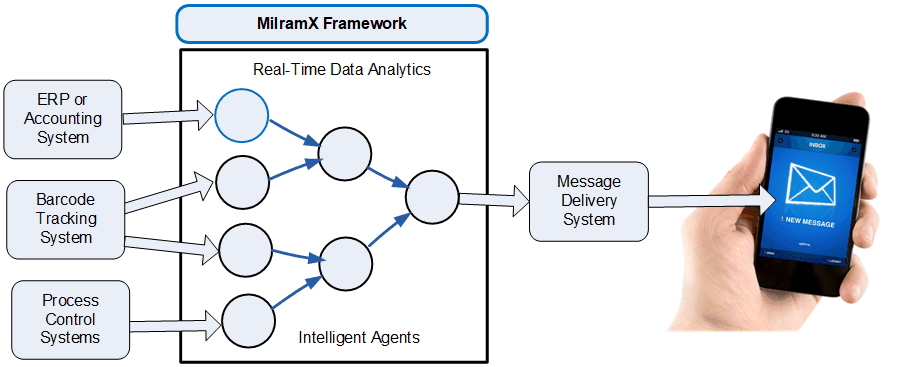
|

MilramX uses the paradigm of intelligent agents which collaborate in real-time to extract data from multiple systems, analyze this data to produce actionable information, and to send this information in the form of Emails of text messages to people. Alternately this information can be used to update systems used by people so that they have the information they need, when they need it.
Decision Support is simply computer code that performs knowledge-based tasks using a variety of data analysis, decision making, and planning algorithms. One of the major problems is that, to do something useful such as control a machine, the body of code quickly becomes very large. Implementing such systems as a set of collaborating intelligent agents has proven to be a good way to organize Real-Time rules-based Decision Support systems.
Real-Time rules-based Decision Support Systems differ from Deep Reasoning AI systems in that these Decision Support Systems capture, analyze and act on data in near real-time whereas deep reasoning systems start with a set of of historical data and extract meaning from it.
Please see "Rules-Based Decision Support versus Deep Reasoning Artificial Intelligence Systems" for more details.
A Real-Time Rules-Based Decision Support System performs a number of functions:
One method for achieving these functions is with hard-coded Decision Trees, which are rapid to execute but inflexible and hard to manage when there are many decisions to be made. Please read "Strengths and Weaknesses of Decision Trees for Decision Support".
These days, building a decision support system is an iterative process, which requires adding and changing decision rules and processes in an "Agile" software development process. Except in simple cases, decision trees do not lend themselves to this programming style.
Expert Systems were invented to overcome some of these problems by enabling users to add to a collection of IF..THEN..ELSE rules as the system is developed using Agile methods. But, as described in "Strengths and Weaknesses of Expert Systems for Decision Support", these systems have limited decision making capabilities and become difficult to debug when there are many rules, which could be fired asynchronously.
The current solution to these problems is to use the paradigm of collaborating-intelligent-agents which integrates the best features of these prior approaches and overcomes some of their weaknesses, as described in "Strengths and Weaknesses of an Intelligent Agent Approach".